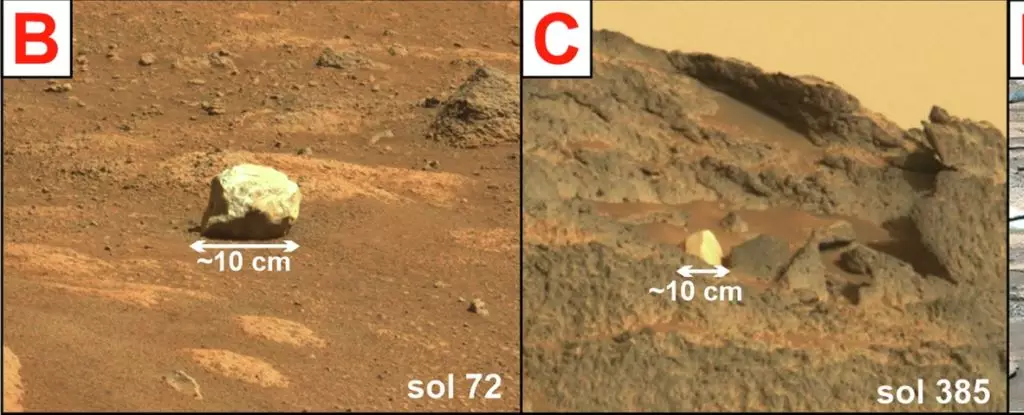The journey to understand Mars, our enigmatic neighboring planet, has taken incredible leaps forward thanks to advances in technology and exploration. Among these advancements are the tireless efforts of NASA’s rovers, Curiosity and Perseverance. Recently, the discovery of pale rocks in Jezero Crater has captured attention and led scientists to re-evaluate their understanding of Martian geology. The mineral composition of these seemingly ordinary rocks suggests that Mars may have once been a warm, wet environment, more akin to Earth than previously thought.
Planetary scientist Roger Wiens from Purdue University emphasizes the significance of the minerals found within these rocks. “These minerals are the remnants of ancient geological processes, echoing conditions where water – potentially life’s essential ingredient – flowed freely,” he explains. This discovery challenges longstanding assumptions about Mars’ climate and geological history, raising questions about the potential for life in the planet’s distant past.
The Role of Water in Mars’ Past
At the heart of the inquiry into Mars’ history lies the element of water. The rocks identified by Perseverance predominantly consist of kaolinite, a type of clay mineral that typically requires temperate and wet conditions for its formation. Wiens notes, “Kaolinite formation on Earth is often tied to environments rich in rainfall or hydrothermal systems, both of which could support life.” Therefore, these findings suggest that, at some point in its history, Mars may have harbored conditions favorable for life—a notion that sparks excitement and intrigue.
The Mars rovers operate as our robotic ambassadors, tasked with unraveling the complexities of a world that has undergone dramatic transformations. Jezero Crater, once thought to be a dry and barren stretch of land, is now revealed to be a potential treasure trove of information about Martian hydrology and climatic evolution. As scientists analyze kaolinite’s presence, they hope to glean insights into the volume and duration of water that may have existed on Mars.
Oddball Rocks: The Float Rocks and Their Mystery
Among the intriguing aspects of these findings are the so-called “float rocks” discovered on Jezero’s surface, which have traversed away from their original locations due to natural processes like erosion and weathering. Initially deemed inconsequential, these pale rocks branched out from common Martian geology, thus drawing the attention of scientists who sought to decipher the hidden stories embedded within them.
Perseverance’s capabilities, particularly its Laser Induced Breakdown Spectroscopy (LIBS) tool, propelled the exploration of these float rocks to new heights. By firing a laser pulse at the rocks, the rover excites atoms within the mineral, allowing for an examination of the light emitted. This innovative approach leads to the identification of various elemental compositions, uncovering a window into Mars’ geological past. The identification of kaolinite and its unique characteristics promises to provide answers to lingering questions about the planet’s earlier climates.
A Unique Composition and its Implications
Along with kaolinite, researchers have observed the presence of spinel, a mineral that further complicates our understanding of the rocks’ origins. Spinel is often associated with gemstones on Earth, yet its presence in Martian soil remains puzzling. How did it integrate with kaolinite? And what does that signify about the geological processes at work on Mars? These questions represent pivotal avenues for future research.
The potential link between these minerals and Mars’ water history could redefine scientific understanding of planetary habitability. Wiens remarks on the urgency of unraveling such complexities: “The big questions about Mars revolve around water: its presence, its history, and ultimately where it has disappeared.” The search for water on Mars is more than just a quest for resources; it embodies the exploration of a former world that might have nurtured life.
A Call to Investigate Further
The implications of these findings extend far beyond academic curiosity. If Mars once had environments that could support life, future missions must prioritize the examination of these intriguing deposits. Understanding how such minerals formed and evolved through geological time could shape our understanding of life’s possibilities beyond Earth. Each discovery adds another layer to the comprehensive narrative of a planet once teeming with activity, and these pale rocks serve as artifacts that could reveal answers to one of humanity’s oldest questions: is there life elsewhere in the universe?
Thus, as we look to the future, the call for exploration echoes louder. Mars, with its float rocks and ancient histories, beckons us to continue our quest for knowledge. The potential for discovering remnants of life, or at least the conditions that fostered it, lies waiting on the dusty plains of this crimson world. Each rock we study brings us one step closer to understanding our cosmic neighbors and the expansive universe around us.

